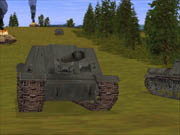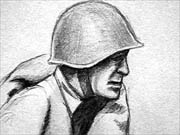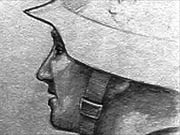Combat Mission: Barbarossa to Berlin Q&A
We spoke with Big Time Software president, Charles Moylan, to get all the latest details on the upcoming sequel to the original Combat Mission.
When Big Time Software released Combat Mission: Beyond Overlord last year, it became one of the most critically acclaimed games in recent years, garnering a lengthy string of glowing reviews and awards. Many feel that this tactical simulation of late World War II combat in Western Europe has single-handedly redefined wargaming's potential.
Unlike most traditional wargames, Combat Mission presents battles in 3D, and it features an intuitive interface and an innovative turn-based/real-time game design. During each turn, you take as much time as you like studying the battlefield and issuing commands to your units during an orders phase. After that, the actions of both sides' troops play out simultaneously in real time during a one-minute action phase. The alternation between careful deliberation and dramatic action gives the game a unique pace, and the meticulous attention to historical detail allows for great realism and tactical subtlety.
Now Big Time Software is hard at work on Combat Mission: Barbarossa to Berlin. As in Combat Mission: Beyond Overlord, the focus will be on company- and battalion-sized battles, with units representing squads, weapons teams, and individual vehicles and field guns. This time, though, the game will center on the brutal fighting between the Axis and Soviet forces on the eastern front. We recently got to talk with Charles Moylan, president of Big Time Software and lead engineer and co-designer of Combat Mission: Barbarossa to Berlin.

GameSpot: What do you feel has been the key to Combat Mission's success, and how do you hope to repeat or build on that success with Combat Mission: Barbarossa to Berlin?
Charles Moylan: It's mainly that we, as gamers, made a game that we really wanted to play, rather than a generic "corporate" game that would (in theory) sell to a mass market.
What that means is that we did a lot of research, got the military history right, and combined that with a cool 3D graphics engine and novel hybrid real-time/turn-based control system, never cutting corners. It took us a long time to build Combat Mission, and I doubt that we would have been allowed to take so much time crafting the game if we were not independent. But since we are, we had that freedom, and I think it was a good decision.
We'll take the same approach with Combat Mission: Barbarossa to Berlin. That's why we don't have a firm ship date--we won't ship the game until we're satisfied that it's truly complete. Combat Mission gamers are on our message board right now making suggestions, helping out with research, and contributing ideas. And we listen to them.
GS: The eastern front conflict was massive in scope. How much of it can we reasonably expect to see modeled in Combat Mission: Barbarossa to Berlin? What specific geographical regions, time periods, and nationalities will be modeled?
CM: The dauntingly massive scale of the eastern front is one reason that our first Combat Mission game took place on the (smaller) western front. It was no accident.
Combat Mission: Barbarossa to Berlin opens with Operation Barbarossa, the German invasion of the Soviet Union in June 1941, and covers the entire period from there until the end of the war in Europe, including the fall of Berlin.
You can count on seeing virtually all the terrain fought over on the eastern front made available in Combat Mission. We're adding new terrain types to the palette, including steppe, tundra, birch forests, soft boggy ground, corduroy roads, and more. Further, we'll have each battle be set in a "region" (southern, central, northern, and arctic), and this will determine or influence local terrain, weather, and balance and availability of various military forces and nations.
Nations included are the Soviet Union, Germany, Finland, Hungary, Italy, Romania, Poland, and Partisans.
GS: What led you to focus on the eastern front in Combat Mission: Barbarossa to Berlin over, say, the fighting in Africa, or some part of the Pacific theater?
CM: General interest in the subject matter. With the exception of the western front, which we visited in Combat Mission, the eastern front is by far the most-requested theater among Combat Mission players. The fighting was so vast, you just can't ignore it.
GS: Combat Mission is notable for its inclusion of many dozens of different armored vehicles, and the armored warfare aspects of the game have become a central focus for many players. Approximately how many different vehicle variants can we expect in Combat Mission: Barbarossa to Berlin? Also, are there any that fans should be particularly excited about?
CM: We don't have a final count yet, but it's huge--somewhere approaching 300 vehicle types and variants. We're even including the ability for sides to use certain captured enemy vehicle types, like Germans using captured [Soviet] T-34 tanks. Plus we'll have lend-lease western tanks used by the Soviets and outfit the armored forces of the Finnish, Romanian, and Hungarian troops too, including their lesser-known and somewhat exotic armored vehicles.
GS: How will the game handle eastern-front armor engagements differently than the armor battles in the first Combat Mission, given their sometimes enormous size, problems with tanks bogging in mud or snow, the difficulties of command and control, and so forth?
CM: Bogging was simulated in Combat Mission and continues into Combat Mission: Barbarossa to Berlin, with the addition of new dangers like soft ground and a relative lack of roads. The low ground pressure of the T-34 will be a decided advantage.

Command and control is being entirely reworked for the new game. Tanks may now be organized in platoons, and it's important for leaders to keep their platoon tanks in contact. This is a lot easier to do if they're equipped with radios, but the Soviets often lacked radios up through 1943. That means that the Soviets often must open their hatches and communicate with hand signals, which is very dangerous when people are shooting at you! Without platoon communication, command delay penalties become pretty severe. Worse yet for the Soviets is that early T-34 tanks, with two-man turrets and no radio, required the tank commander to drop down into the turret in order to fire the main gun, automatically taking him out of visual contact with the other tanks in his platoon. This creates a serious command problem for the Soviet player in Combat Mission: Barbarossa to Berlin.
GS: What sorts of unique factors, like morale, dangerously cold weather, and so forth, will come into play when modeling infantry on the eastern front? How will these set the game apart from Combat Mission: Beyond Overlord?
CM: We've added a new rating for troops: fitness. Low fitness leads to greater fatigue unless you stay put, which of course limits your tactical options. This is separate from experience, which now allows us to simulate poorly trained Russian conscripts who are young and healthy men straight off the farm, but who have received little to no military training. We can also simulate depleted elite soldiers, who are low on food and have been in battle far too long.
GS: How will you handle the complexities of urban combat? What changes will you make to the way movement and combat in buildings are handled? You've said that you'll be modeling some of the combat that took place in Stalingrad's sewer system. What special challenges does this underground warfare present to the game design?
CM: We haven't implemented the sewer system yet, but I can outline our goals. It will be abstracted. You'll be allowed to tell your troops to enter the sewer and set a desired spot from which to emerge. But you are not guaranteed that they'll make it! And the time it takes can vary widely. Better-trained troops have a better chance, but conscripts may well get lost and never be heard from again.
GS: Can we expect any new orders in Combat Mission: Barbarossa to Berlin? Perhaps something like an "advance to contact" command that would send infantry forward and cause them to stop and take available cover after coming under fire?
CM: This was one of our top priorities. Here are the new orders you can look forward to (the list may grow further):
Move to contact: Just as you described. Useful at the beginning of the game for a cautious advance.
Assault: The squad moves ahead in "leapfrog" style, with some men prone, offering covering fire, and the others running a short distance ahead. Then the two groups switch--the firers get up and move and the movers stop to fire. This is internal to the squad, so the average overall movement speed is around walking speed (the average of half-sprinting and half-stopped prone). So the speed is only moderate, but the advantage is decent use of available cover and the ability to return fire with most weapons (not the heavy ones like LMGs [light machine guns, as opposed to standard infantry rifles]). This is important because the "run" command in Combat Mission: Barbarossa to Berlin allows for much less outgoing fire than it did in Combat Mission, pretty much just limiting it to SMGs [submachine guns] at very close range.

Human wave: Inexperienced troops are not allowed to use the "assault" command, but Soviets can use the "human wave" as an alternate. It involves the troops moving ahead at a brisk walk, firing available SMGs and throwing grenades once in range. Vulnerability is high so casualties are usually brutal, but morale stiffens (to a point) and it may allow you to overwhelm a tough enemy defense at close range through greater numbers.
Hull down (vehicles only): Pick a spot on the map and your vehicle will move toward it until it has a hull-down firing angle on that spot. Movement is rather slow, but higher-experience units can do it faster.
Cover arc: Click on two points and your unit will direct its attention to the triangular area created by those two limiting points and your unit's location. Except in extreme circumstances, your unit will only open fire on enemies inside this zone. So you can set the direction and range of engagement, which is very useful for ambush (which this command replaces), conserving ammo, or focusing a directed defense.
GS: What are the basic criteria you use in evaluating something for inclusion in the game? Considering the scope of the eastern front, there must be numerous unit types and historical factors all begging for consideration or inclusion.
CM: It's hard to state this precisely. We just try to gauge whether a weapon or unit was used with regularity [and] is distinct enough from other similar weapons/units to be worth its own representation, especially at the company and battalion level. Sometimes we make exceptions just for fun. For example, we plan to include the gigantic assault-rocket-firing Sturmtiger [a German armored vehicle] even though only something like 18 of them were ever built. It will have an insanely high "rarity factor" of course.
GS: Combat Mission is known for its very active fan community, and you've hired a fan to work on the interface for Combat Mission: Barbarossa to Berlin. How much do you rely on fans to provide material for Combat Mission: Barbarossa to Berlin or test the game? More generally, how much does fan input affect your design decisions?
CM: Fans supplied a fantastic number of graphical and sound "mods" for Combat Mission. We were amazed at the level of talent and dedication out there. So we're tapping into that in a more "official" capacity for Combat Mission: Barbarossa to Berlin. As you mentioned, one fan has redone our in-game interface art. Others will contribute shortly, as development continues. Testing relies heavily on our group of "outside" (for lack of a better word) beta testers who are also big fans of the game. The game is just too intricate for us to test it properly on our own, internally, and not miss something. As for fan input affecting our decisions, it's more that fans make interesting suggestions for things that we may have overlooked or ways to simplify elements in the game or make them more interesting. We put out the basic plan, and then the fans debate it and try to improve it, and we end up incorporating many of their ideas.
GS: The importance of graphics is sometimes a heated topic of debate among Combat Mission fans. What sorts of graphical improvements will we see in Combat Mission: Barbarossa to Berlin, and how do you balance improvements in that sphere versus others?
CM: We're using the same core engine from Combat Mission, but this time with higher-resolution 3D graphics textures. The average person's 3D hardware has advanced since we released Combat Mission, so we want to take advantage of that. Still, the game is automatically scalable and will even run an 8MB card (though we recommend 32MB), so we won't leave people behind.
We're also planning to add some graphical touches that will give some more "height" to certain terrain types, improve some of the flash/fire graphics, and more.
GS: The "skins," or external appearances of units, in Combat Mission are open to modification, and fans have produced a huge variety of graphics mods. Will further aspects of the game, like the underlying 3D models or unit statistics, be open to modification in Combat Mission: Barbarossa to Berlin?
CM: No. We optimize the bejesus out of the 3D model code (we actually compile the models directly into hard-coded computer instructions), so there's no easy way to open that up without degrading game performance.
And we don't want to allow editing of unit statistics because then you'd have a million different flavors of Combat Mission floating around everywhere, and no one can play anyone else and know that they haven't made wacky changes to the data. We strive very hard to get our data right, and we correct mistakes when they're shown to us, so there's really no need for unit editing in the first place. I think our track record here speaks well to that.
GS: Can we expect any special features with the game's audio? Will different nationalities speak in their native languages, as in the first Combat Mission, and will there be an option to have them all use English phrases?
CM: We plan to have the different nationalities all speak in their native languages (and boy there are a lot in the new game! We're still working on that). Probably no option to switch to English, as understanding the words is not crucial. It's more for atmosphere.
GS: Will there be any new multiplayer modes or options in Combat Mission: Barbarossa to Berlin?
CM: No. We support TCP/IP, hotseat, and play by e-mail.
GS: Combat Mission is rather unusual for its marketing and sales strategy. You've only sold the game directly through your Web site and seem to do little traditional advertising. What are the strengths and drawbacks of such an approach? Will Combat Mission: Barbarossa to Berlin be sold the same way, or can we expect it in stores as well?
CM: We're right in the middle of expanding our European marketing and distribution for Combat Mission, so what happens there will affect what we do with Combat Mission: Barbarossa to Berlin. That said, the main thrust of our marketing will be similar to that of [the original Combat Mission], meaning that we'll continue to sell primarily through our Web site. It's gone so well for us so far that there's no reason to change. Plus we enjoy being independent, which lets us retain artistic control and make better games rather than crank out something corporate and bland.
GS: Thanks, Charles.
Got a news tip or want to contact us directly? Email news@gamespot.com
Join the conversation